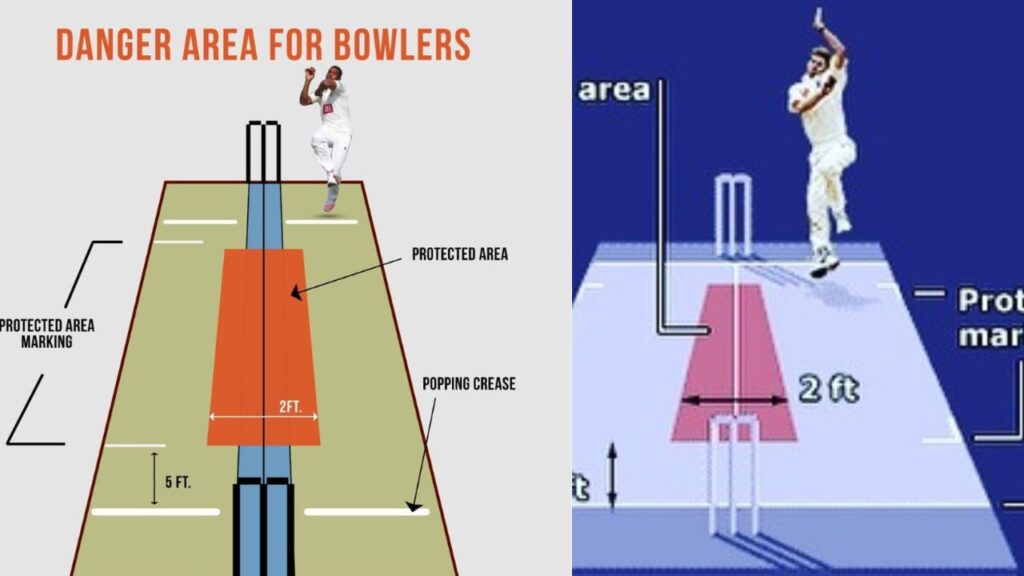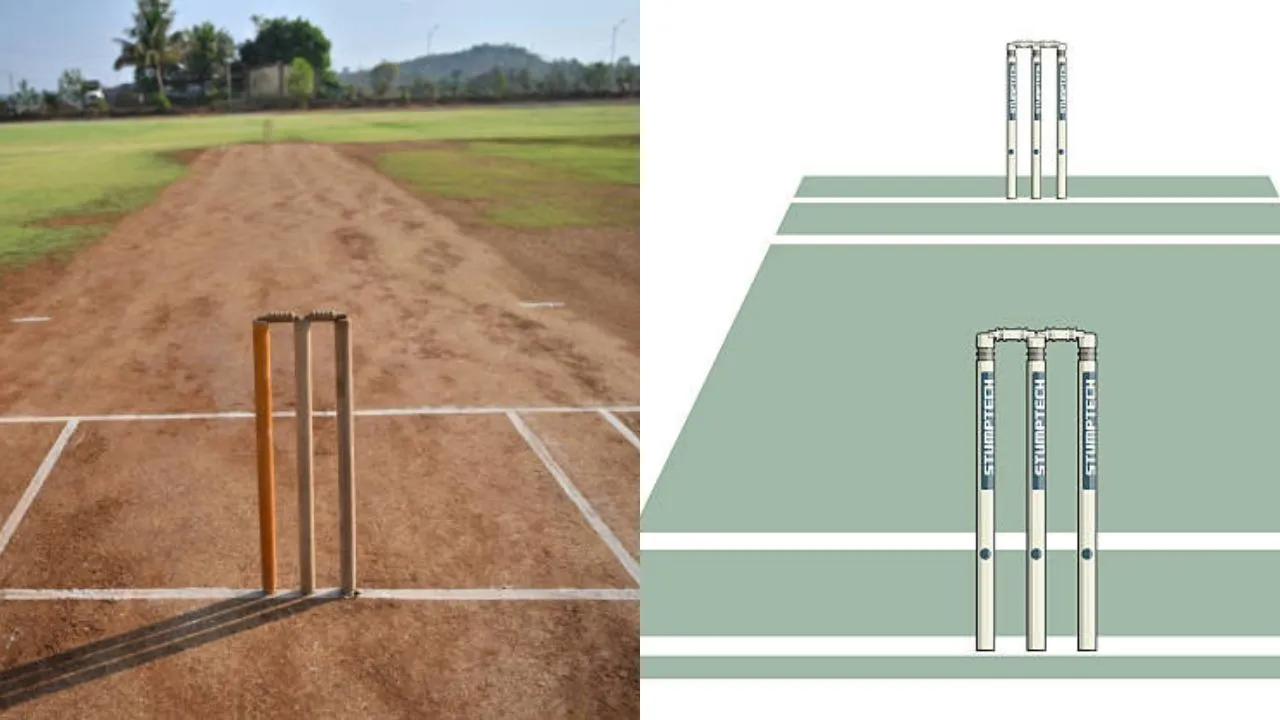Cricket, often referred to as the “gentleman’s game,” is known for its rich traditions and complex rules. For players, understanding the nuances of the cricket pitch is crucial. As a cricketer, whether you’re an aspiring professional or just enjoy a casual game on the weekends, understanding the pitch is fundamental. In this comprehensive guide, we will walk you through the dimensions, the protected area, the surface, and its various sections. By the end, you’ll be well-versed in the key aspects of a cricket pitch.
What Is Pitch In Cricket?
The pitch, often considered the heart of the cricket field, is the area where most of the game’s action takes place. It serves as the stage for bowlers and batsmen, a place of strategy and skill. Before we explore the dimensions and details of a cricket pitch. It is 22 yards (20.12 meters) long and 10 feet (3.05 meters) wide.
Protected Area in Pitch:

The protected area is a rectangular zone on the cricket pitch, typically marked by white lines or painted on the ground. It is situated right in the middle, halfway between the two sets of stumps, where the batsmen stand. This area usually extends for a certain length, generally around 5 feet (1.52 meters) from the middle of the pitch.
Under the Laws of Cricket, bowlers are strictly prohibited from running on or encroaching into this protected area during their follow-through after delivering the ball. This rule is in place to ensure a fair contest between the bowler and batsman. When a bowler breaks this rule by stepping on the protected area, the umpire can penalize it with a no-ball, and any runs the batsmen get at that moment will be counted as extras.
The surface of the Pitch:
- Flat Surface: A cricket pitch should have a flat surface. Any irregularities or undulations on the pitch can make it challenging for the bowlers and the batsmen.
- Short Grass: The grass on the pitch should be kept short to allow the ball to bounce predictably. Grass that is too long can slow down the ball and make it unpredictable.
- Dry or Dusty Soil: The soil on the pitch is usually dry or dusty. This ensures that the pitch doesn’t offer excessive assistance to the bowlers. It’s a fine balance between helping the bowlers and providing a fair contest.
Use of Cricket Pitch:
The cricket pitch is a versatile piece of the playing field. Here are its primary uses:
1. Bowling:
The bowlers use the pitch as their stage. They aim to deliver the ball in such a way that it troubles the batsman and increases the chances of taking a wicket.
2. Fielding:
Fielders also have a crucial role on the pitch. They need to be positioned strategically to stop the ball and try to dismiss the batsmen through catches or run-outs.
3. Batting:
Batsmen need to master the pitch’s conditions. The bounce and turn on the pitch can vary, and adaptability is key for successful batting.
4. Fielding Practice Session:
Fielding practice often occurs on the pitch. Players improve their catching and ground fielding skills to become agile and effective fielders.
Cricket Pitch Measurement and Dimensions:
Understanding the dimensions of the cricket pitch is a fundamental aspect of the game for players at all levels. Cricket standardizes the precise measurements of the pitch to ensure fairness and consistency across formats. Let’s explore how various units measure the length of the pitch:
1- Cricket Pitch Length in Meters:
The standard length of a cricket pitch is 20.12 meters. In international cricket, players often use this measurement. It’s important for both bowlers and batsmen as they figure out where to stand and plan their moves based on this length.
2- Cricket Pitch Length in Feet:
For those who prefer imperial units, the pitch measures 66 feet in length. This measurement provides a familiar frame of reference for many players and fans, especially in countries where the metric system is not the primary unit of measurement.
3- Cricket Pitch Length in Steps:
In some informal settings, players might use the number of steps to estimate the pitch length. The pitch typically measures 132 steps from end to end. This method can be handy for quick approximations during informal games or practice sessions.
4- Cricket Pitch Length in Yards:
The most commonly used measurement for the length of a cricket pitch is in yards. A standard cricket pitch is 22 yards long. In cricket, we use this unit of measurement because it’s a long-standing tradition and the preferred way to talk about the pitch’s length during the game.
What Is The Length Of A Cricket Pitch?
The length of a cricket pitch is 22 yards or 20.12 meters. This length is consistent across all formats of the game, from Test matches to T20I games. It is important to note that the width of the pitch is 10 feet or 3.05 meters.
What is the Shape of a Cricket Pitch?
The shape of a cricket pitch is rectangular. It is a long, narrow strip that measures 22 yards (20.12 meters) in length and 10 feet (3.05 meters) in width. This rectangular shape is consistent across all formats of the game and serves as the central playing area where most of the cricketing action takes place.
In addition to the overall shape of the pitch, there are specific areas on the pitch that play distinct roles in the game:
1- Crease:
The crease is a marked area at both ends of the pitch. It consists of two primary components:
- Batting Crease: This is where the striker (batsman facing the bowler) stands while taking guard. It’s a line marked just in front of the wicket.
- Popping Crease: The popping crease, which is placed 4 feet and 4 inches (1.32 meters) away from the batting crease, is where batsmen need to stay or return to in order to avoid getting run out.
2- Wickets:
- The wickets are the key targets for the bowlers and fielding side. Each wicket comprises three wooden stumps and two bails. At each end of the pitch, the players put the wickets. The bowler’s main goal is to hit or knock over the stumps to get the batsman out. This is the ultimate goal in cricket, and wicket-taking is a central aspect of the game.
Conclusion:
In conclusion, remember that a cricket pitch isn’t just any field; it’s where legends make their mark, strategies come to life, and the spirit of the game thrives. Understanding its dimensions and various elements is key for any cricketer, whether you’re a novice or an experienced player. This article builds a strong base for players at any level, making sure you’re ready to handle the ups and downs of the cricket pitch.


